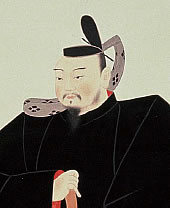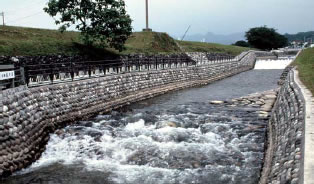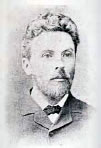Efforts have been made to control the Joganji River since the middle of the 16th century.
Early in the 20th century, field survey up to the upper part of the Joganji River were conducted by engineers invited from overseas by the Japanese government, However, the countermeasures in the upstream area were not carried out due to the technical and financial difficulties, and then only the river improvement works were conducted.
Since 1906, the sabo project upstream of the Joganji River started by Toyama prefecture, but it was difficult construction due to repeated severe natural environment, equipment was destroyed.
Levee Construction by Narimasa Sassa
The first person to conduct pioneering river improvement works for Joganji River was Narimasa Sassa who was a military commander in the Civil War era. When he dominated the Ecchu region in 1580, he immediately saw the flood of the Joganji river and planned building a stone levees to protect his administrative area from the flood. It is estimated "Sassa leeves" was a stone stuck on the riverbed and both riverbanks. It has been subsequently buried due to the continuous rise of the riverbed and part of the crown can only barely be seen today at the bottom of the Josai-Goguchi Irrigation Channel.

Portrait of Narimasa Sassa
(from Toyama City Folk Museum)
Sassa levee (laid out diagonally across the canal bed)
River Improvement Work by J.de Rijke

Compelled by the great flood which hit Toyama City in 1891, the central government sent J.de Rijke, a Dutch engineer, to Toyama to lead the implementation of preventive measures. To improve Joganji River, J.de Rijke created a new flood control channel of some 7 km in length to replace the old dog-legged channel in the lower reaches of Joganji River and widened the river width in the upper reach of the 4 km point from the river mouth to create a regulation reservoir to store sediment. He also constructed a number of new levees and improved old levees in the section between the river mouth and Kamitaki.

Johannis de Rijke (1842~1913)
Born in the Netherlands. In 1873, J.de Rijke came to Japan as a foreign expert in Government employ. During 30 years of his service in Japan, J.de Rijke gave guidance on improvement of Yodo River, Kiso River and Joganji River and transferred the Western's latest water control engineering to Japan.
Sabo Works in Toyama Prefecture
Realizing the importance of sabo works at the upstream of the Joganji River from the experience of the 1896 Flooding, Toyama Prefecture started sabo works at the upstream of the river with a financial assist from the national government in 1906. However, Yukawa No.1 Sabo Dam (constructed at the location of the current Shiraiwa Sabo Dam), which was the very foundation of the entire sabo work, was destroyed by the 1919 Flood. Although the dam was reconstructed, it was destroyed again by a heavy rainfall in July 1922.

A series of sabo dams using giant rocks in Nishi Yotsunoya
Yukawa No.1 Sabo Dam constructed by Toyama Prefecture in 1919
Yukawa No.1 Sabo Dam destroyed by a heavy rainfall in 1922
Petition for Sabo Work as a National Project
Toyama Prefecture continually requested for an involvement of the national government in sabo project in Tateyama as a national project. The damage of Yukawa No.1 Sabo Dam in 1922 triggered a growing demand for a national involvement in the sabo project, which ended up being taken over by the national government in May 1926.
 An epigraph in the hope for peaceful mountains, clear streams and no disasters inscribed in 1917
An epigraph in the hope for peaceful mountains, clear streams and no disasters inscribed in 1917 An article advocating for a national involvement in sabo works appeared in "Toyama Daily" on August 23, 1922
An article advocating for a national involvement in sabo works appeared in "Toyama Daily" on August 23, 1922
